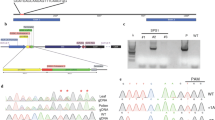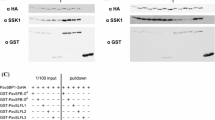Abstract
A class of ribonucleases termed S-RNases, which control the pistil expression of self-incompatibility, represents the only known functional products encoded by the S locus in species from the Solanaceae, Scrophulariaceae and Rosaceae. Previously, we identified a pollen-specific F-box gene, AhSLF (S locus F-box)-S 2, very similar to S 2 -RNase in Antirrhinum, a member of the Scrophulariaceae. In addition, AhSLF-S 2 also detected the presence of its homologous DNA fragments. To identify these fragments, we constructed two genomic DNA libraries from Antirrhinum self-incompatible lines carrying alleles S 1 S 5 and S 2 S 4, respectively, using a transformation-competent artificial chromosome (TAC) vector. With AhSLF-S 2-specific primers, TAC clones containing both AhSLF-S 2 and its homologs were subsequently identified (S 2 TAC, S 5 TACa, S 4 TAC, and S 1 TACa). DNA blot hybridization, sequencing and segregation analyses revealed that they are organized as single allelic copies (AhSLF-S 2, -S 1, -S 4 and -S 5) tightly linked to the S-RNases. Furthermore, clusters of F-box genes similar to AhSLF-S 2 were identified. In total, three F-box genes (AhSLF-S 2, -S 2 A and -S 2 C) in S 2 TAC (51 kb), three (AhSLF-S 4, -S 4 A and -S 4 D) in S 4 TAC (75 kb), two (AhSLF-S 5 and -S 5 A) in S 5 TACa (55 kb), and two (AhSLF-S 1 and -S 1 E) in S 1 TACa (71 kb), respectively, were identified. Paralogous copies of these genes show 38–54% identity, with allelic copies sharing 90% amino acid identity. Among these genes, three (AhSLF-S 2 C, -S 4 D and -S 1 E) were specifically expressed in pollen, similar to AhSLF-S 2, implying that they likely play important roles in pollen, whereas three AhSLF-SA alleles showed no detectable expression. In addition, several types of retroelements and transposons were identified in the sequenced regions, revealing some detailed information on the structural diversity of the S locus region. Taken together, these results indicate that both single allelic and tandemly duplicated genes are associated with the S locus in Antirrhinum. The implications of these findings in evolution and possible roles of allelic AhSLF-S genes in the self-incompatible reaction are discussed in species like Antirrhinum.








Similar content being viewed by others
References
Ai Y, Singh A, Coleman CE, Ioerger TR, Kheyr-Pour A (1990) Self-incompatibility in Petunia inflata: isolation and characterization of cDNA encoding S-allele-associated proteins. Sex Plant Reprod 3:130–138
Anderson MA, Cornish EC, Mau SL, Williams EG, Hoggart R, Atkinson A, Bonig I, Grego B, Simpson R, Roche PJ, Haley JD, Penshow JD, Niall HD, Tregear GW, Coghlan JP, Crawford RJ, Clarke AE (1986) Cloning of a cDNA for a style glycoprotein associated with expression of self-incompatibility in Nicotiana alata. Nature 321:38–44
Broothaerts W, Janssens GA, Proost P, Broekaert W (1995) cDNA cloning and molecular analysis of two self-incompatibility alleles from apple. Plant Mol Biol 27:499–511
Cheng Z, Dong F, Langdon T, Ouyang S, Buell CR (2002) Functional rice centromeres are marked by a satellite repeat and a centromere-specific retrotransposon. Plant Cell 14:1691–1704
Coleman CE, Kao TH (1992) The flanking region of two Petunia inflate S alleles are heterogenous and contain repetitive sequences. Plant Mol Biol 18:725–737
Copenhaver GP, Nickel K, Kuromori T, Benito MI, Kaul S (1999) Genetic definition and sequence analysis of Arabidopsis centromeres. Science 286:2468–2474
Duret L, Marais G, Biemont C (2000) Transposons but not retrotransposons are located preferentially in regions of high recombination rate in Caenorhabditis elegans. Genetics 156:1661–1669
Ellis J, Dodds P, Pryor T (2000a) The generation of plant disease resistance gene specificities. Trends Plant Sci 5:373–379
Ellis J, Dodds P, Pryor T (2000b) Structure, function and evolution of plant disease resistance genes. Curr Opin Plant Biol 3:278–284
Emerson S (1939) A preliminary survey of the Oenothera organensis population. Evolution 24:524–537
Entani T, Iwano M, Shiba H, Takayama S, Fukui K (1999) Centromeric localization of an S-RNase gene in Petunia hybrida Vilm. Theor Appl Genet 99:391–397
Entani T, Iwano M, Shiba H, Che F, Isogai A, Takayama S (2003) Comparative analysis of the self-incompatibility (S-) locus region of Prunus mume: identification of a pollen-expressed F-box gene with allelic diversity. Genes Cells 8:203–213
Foote HC, Ride JP, Franklin-Tong VE, Walker EA, Lawrence MJ, Franklin FCH (1994) Cloning and expression of a distinctive class of self-incompatibility (S-) gene from Papaver rhoeas L. Proc Natl Acad Sci USA 91:2265–2269
Frey M, Tavantzis SM, Saedler H (1989) The maize En/Spm element transposes in tomato. Mol Gen Genet 217:172–177
Fu H, Zheng Z, Dooner HK (2002) Recombination rates between adjacent genic and retrotransposon region in maize vary by 2 orders of magnitude. Proc Natl Acad Sci USA 99:1082–1087
Golz JF, Su V, Clarke AE, Newbigin EA (1999) A molecular description of mutations affecting the pollen component of the Nicotiana alata S locus. Genetics 152:1123–1135
Golz JF, Clarke AE, Newbegin E (2000) Mutational approaches to the study of self-incompatibility: revisiting the pollen part mutations. Ann Bot 85:95–103
Golz JF, Oh HY, Su V, Kusaba M, Newbigin E (2001) Genetics analysis of Nicotiana pollen-part mutant is consistent with the presence of an S-ribonuclease inhibitor at the S locus. Proc Natl Acad Sci USA 98:15372–15376
Hammond-Kosack KE, Tang S, Harrison K, Jones JD (1998) The tomato Cf-9 disease resistance gene functions in tobacco and potato to confer responsiveness to the fungal avirulence gene product Avr 9. Plant Cell 10:1251–1266
Igic B, Kohn JR (2001) Evolutionary relationships among self-incompatiblity RNases. Proc Natl Acad Sci USA 98:13167–13171
Kachroo A, Schopfer CR, Nasrallah ME, Nasrallah JB (2001) Allele-specific receptor-ligand interactions in Brassica self-incompatibility. Science 293 1824–1826
Lai Z, Ma W, Han B, Liang L, Zhang Y, Hong G, Xue Y (2002) An F-box gene linked to the self-incompatibility (S) locus of Antirrhinum is expressed specifically in pollen and tapetum. Plant Mol Biol 50:29–42
Lawrence MJ, Lane MD, O'Donnell S, Franklin-Tong VE (1993) The population genetics of the self-incompatibility polymorphism in Papaver rhoeas. V. Cross-classification of the S-alleles of samples from three natural populations. Heredity 71:581–590
Li JH, Nass N, Kusaba M, Dodds PN, Treloar N, Clarke AE, Newbigin E (2000) A genetic map of the Nicotiana alata S locus that includes three pollen-expressed genes. Theor Appl Genet 100:956–964
Liu YG, Whitter RF (1994) Rapid preparation of megabase plant DNA from nuclei in agarose plugs and microbeads. Nucleic Acids Res 22:2168–2169
Liu YG, Shirano Y, Fukaki H, Yanai Y, Tasaka M (1999) Complementation of plant mutants with large genomic DNA fragments by a transformation-competent artificial chromosome vector accelerates positional cloning. Proc Natl Acad Sci USA 96:6535–6540
Liu YG, Nagaki K, Fujita M, Kawaura K, Uozumi M, Ogihara Y (2000) Development of an efficient maintenance and screening system for large-insert genomic DNA libraries of hexaploid wheat in transformation-competent artificial chromosome (TAC) vector. Plant J 23:687–695
Luu DT, Qin X, Morse D, Cappadocia M (2000) S-RNase uptake by compatible pollen tubes in gametophytic self-incompatibility. Nature 407:649–651
Luu DT, Qin X, Laublin G, Yang Q, Morse D, Cappadocia M (2001) Rejection of S-heteroallelic pollen by a dual-specific S-RNase in Solanum chacoense predicts a multimeric SI pollen component. Genetics 159:329–335
Ma W, Zhou J, Lai Z, Zhang Y, Xue Y (2002) The self-incompatibility (S) locus is located in a pericentromeric region in Antirrhinum. Acta Bot Sin 45:47–52
Martin GB, Brommonschenkel SH, Chunwongse J, Frary A, Ganal MW (1993) Map-based cloning of a protein kinase gene conferring disease resistance in tomato. Science 262:1432–1436
May G, Matzke E (1995) Recombination and variation at the mating-type of Coprinus-cinereus. Mol Biol Evol 12:794–802
McClure BA, Haring V, Ebert PR, Anderson MA, Simpson RJ, Sakiyama F, Clarke AE (1989) Style self-incompatibility gene products of Nicotiana alata are ribonucleases. Nature 342:955–957
McCubbin AG, Kao TH (2000) Molecular recognition and response in pollen and pistil interactions. Annu Rev Cell Dev Biol 16:333–364
McCubbin AG, Wang X, Kao TH (2000) Identification of self-incompatibility (S-) locus linked pollen cDNA markers in Petunia inflata. Genome 43:619–627
Michelmore RW, Meyers BC, (1998) Clusters of resistance genes in plants evolve by divergent selection and a birth-and-death process. Genome Res 8:1113–1130
Nacken WK, Piotrowiak R, Suedler H, Sommer H (1991) The transposable element Tam1 from Antirrhinum majus shows structural homology to the maize transposon En/Spm and has no sequence specificity of insertion. Mol Gen Genet 228:201–208
Nettancourt D de (2001) Incompatibility and incongruity in wild and cultivated plants, 2nd edn. Springer, Berlin Heidelberg New York
O'hUigin C (1995) Quantifying the degree of convergence in primate MHC-DRB genes. Immunol Rev 143:123–140
Pandy KK (1965) Centric chromosome fragments and pollen-part mutation of the incompatibility gene in Nicotiana alata. Nature 206:792–795
Richman AD, Uyenoyama MK, Kohn JR (1996) S-allele diversity in a natural population of Physalis crassifolia (Solanaceae) (ground cherry) assessed by RT-PCR. Heredity 76:497–505
Rizzon C, Marais G, Gouy M, Biemont C (2002) Recombination rate and the distribution of transposable elements in the Drosophila melanogaster genome. Genome Res 12:400–407
Royo J, Nass N, Matton DP, Okamto S, Clarke AE, Newbigin E (1996) A retrotransposon-like sequence linked to the S-locus of Nicotiana alata is expressed in styles in response to touch. Mol Gen Genet 250:180–188
Sassa H, Nishio T, Kowyama Y, Hirano H, Koba T (1996) Self-incompatibility (S) alleles of the Rosaceae encode members of a distinct class of the T2/S ribonuclease superfamily. Mol Gen Genet 250:547–557
Schopfer CR, Nasrallah ME, Nasrallah JB (1999) The male determinant of self-incompatibility in Brassica. Science 286:1697–1700
Sims TL, Ordanic M (2001) Identification of a S-ribonuclease-binding protein in Petunia hybrida. Plant Mol Biol 47:771–783
Stein JC, Howlett B, Boyes DC, Nasrallah ME, Nasrallah JB (1991) Molecular cloning of a putative receptor protein kinase encoded at the self-incompatibility locus of Brassica oleracea. Proc Natl Acad Sci USA 88:8816–8820
Steinbachs JE, Holsinger KE (2002) S-RNase-mediated gametophytic self-incompatibility is ancestral in eudicots. Mol Biol Evol 19:825–829
Suzuki G, Kai N, Hirose T, Fukui K, Nishio T (1999) Genomic organization of the S locus: Identification and characterization of genes in SLG/SRK region of S(9) haplotype of Brassica campestris(syn. rapa). Genetics 3:391–400
Takayama S, Shimosato H, Shiba H, Funata M, Che FS, Watanabe M, Iwano M, Isogai A (2001) Direct ligand-receptor complex interaction controls Brassica self-incompatibility. Nature 413:534–536
Ushijima K, Sassa H, Hirano H (1998) Characterization of the flanking regions of S-RNase genes of Japanese pear (Pyrus serotina) and apple (Malus×domestica). Gene 211:159–167
Ushijima K, Sassa H, Dandekar A, Gradziel T, Tao R, Hirano H (2003) Structure and transcriptional analysis of the self-incompatibility locus of Almond: identification of a pollen-expressed F-box gene with haplotype-specific polymorphism. Plant Cell 15:771–781
Wei F, Wing RA, Wise RP (2002) Genome dynamics and evolution of the Mla (Powdery Mildew) resistance locus in barley. Plant Cell 14:1903–1917
Wheeler MJ, Franklin-Tong VE, Franklin FCH (2001) The molecular and genetics basis of pollen-pistil interactions. New Phytol 151:565–584
Xue Y, Carpenter R, Dickinson HG, Coen ES (1996) Origin of allelic diversity in Antirrhinum S locus RNases. Plant Cell 8:805–814
Acknowledgements
We are grateful to E.S. Coen and R. Carpenter for providing Antirrhinum plants and constant support and Y. Liu for help in constructing TAC library. We also thank J. Huang, H. Qiao and H. Wang and, in particular, an anonymous reviewer for their helpful comments on the manuscript. The work was supported by the Chinese Academy of Sciences and the National Natural Science Foundation of China (39825103).
Author information
Authors and Affiliations
Corresponding author
Additional information
Sequence data from this article have been deposited with the EMBL/GenBank databases under accession numbers AJ300474, AJ515534, AJ515536 and AJ515535
Rights and permissions
About this article
Cite this article
Zhou, J., Wang, F., Ma, W. et al. Structural and transcriptional analysis of S-locus F-box genes in Antirrhinum . Sex Plant Reprod 16, 165–177 (2003). https://doi.org/10.1007/s00497-003-0185-5
Received:
Accepted:
Published:
Issue Date:
DOI: https://doi.org/10.1007/s00497-003-0185-5




